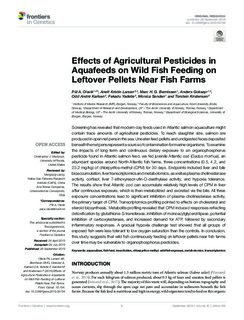Effects of agricultural pesticides in aquafeeds on wild fish feeding on leftover pellets near fish farms
Olsvik, Pål Asgeir; Larsen, Anett Kristin; Berntssen, Marc; Goksøyr, Anders; Karlsen, Odd Andre; Yadetie, Fekadu; Sanden, Monica; Kristensen, Torstein
Journal article, Peer reviewed
Published version
Permanent lenke
http://hdl.handle.net/11250/2635595Utgivelsesdato
2019Metadata
Vis full innførselSamlinger
- Articles [3012]
- Publikasjoner fra CRIStin [3070]
Sammendrag
Screening has revealed that modern-day feeds used in Atlantic salmon aquaculture might contain trace amounts of agricultural pesticides. To reach slaughter size, salmon are produced in open net pens in the sea. Uneaten feed pellets and undigested feces deposited beneath the net pens represent a source of contamination for marine organisms. To examine the impacts of long-term and continuous dietary exposure to an organophosphorus pesticide found in Atlantic salmon feed, we fed juvenile Atlantic cod (Gadus morhua), an abundant species around North Atlantic fish farms, three concentrations (0.5, 4.2, and 23.2 mg/kg) of chlorpyrifos-methyl (CPM) for 30 days. Endpoints included liver and bile bioaccumulation, liver transcriptomics and metabolomics, as well as plasma cholinesterase activity, cortisol, liver 7-ethoxyresor-ufin-O-deethylase activity, and hypoxia tolerance. The results show that Atlantic cod can accumulate relatively high levels of CPM in liver after continuous exposure, which is then metabolized and excreted via the bile. All three exposure concentrations lead to significant inhibition of plasma cholinesterase activity, the primary target of CPM. Transcriptomics profiling pointed to effects on cholesterol and steroid biosynthesis. Metabolite profiling revealed that CPM induced responses reflecting detoxification by glutathione-S-transferase, inhibition of monoacylglycerol lipase, potential inhibition of carboxylesterase, and increased demand for ATP, followed by secondary inflammatory responses. A gradual hypoxia challenge test showed that all groups of exposed fish were less tolerant to low oxygen saturation than the controls. In conclusion, this study suggests that wild fish continuously feeding on leftover pellets near fish farms over time may be vulnerable to organophosphorus pesticides.
